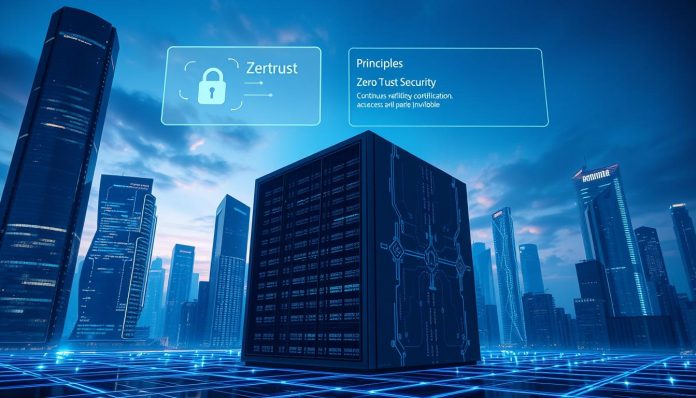Enterprise protection is of utmost importance in the present digital world. The classical security models have been found to be unsuitable in dealing with advanced cyber threats. This is where Zero Trust Security enters the picture, transforming the manner used by the organizations to security.
Zero Trust Security is designed based on the principle of authorization of users and devices before they get access to sensitive information and applications. A Zero Trust model can help enterprises to greatly improve their cyber security posture, deterring the threat of data breaches and cyber attacks.
Key Takeaways:
- Zero Trust Security is one of the contemporary methods of protecting an enterprise.
- It authenticates the user and the device after which it allows access.
- Zero Trust makes cyber security better.
- Minimizes data breach and cyber attacks.
- Vital to the survival of enterprises in the present day.
The Zero Trust Model of Cyber Security:
As advanced cyber threats have increased, a Zero Trust policy approach can be important to enterprise security. The past security models have been heavily based on the perimeter-based security, yet the growing complexity of networks and the rise of remote work has revealed the weakness of this strategy.
The Metamorphosis of Perimeter-Based Security:
The classical perimeter-based approach to security is slowly fading away as the contemporary networks are more distributed. Zero Trust solves this by assuming that it might be both external and internal threats to the network. This model involves the constant verification and monitoring of the users and devices.
Basic Tenets of Zero Trust Architecture:
Zero Trust Architecture is constructed to some main principles, such as verifying explicitly, least privilege access, and assuming breach. Verifying explicitly refers to authentication of users and devices according to several factors. Least privilege access only allows user access to resources that they are required to work with.
| Principle | Description |
| Verify Explicitly | Authenticate users and devices based on multiple factors |
| Least Privilege Access | Limit user access to necessary resources |
| Assume Breach | Prepare for potential breaches by monitoring and responding quickly |
With these principles, organizations will be able to improve their IT Security posture considerably.
Significant elements of Zero Trust Implementation:
To have a clear picture of what the essence of Zero trust is, it is key that any organization intending to implement this security model understands the essence of what it entails. Decent Zero Trust implementation is based on a number of major components which cooperate to ensure powerful Network Security and Data Protection.
IAM and Identity Management:
Identity and Access Management (IAM) is an essential part, and the need to control user identities and their access to resources is important. IAM can be used to make sure that sensitive applications and data can be accessed by authorized users.
Micro-segmentation Strategies:
Micro-segmentation entails breaking down of the network into smaller segments that are isolated and have its own access controls. Such a strategy restricts horizontal movement in case of a breach, better Network Security in general.

Contactless Coordination and Assessment:
Monitors and verifications need to be continuous so that threats can be detected and dealt with in real-time. On this element, Data Protection is guaranteed by the ability to identify any form of suspicious behavior and respond to it in time.
| Component | Description | Benefit |
| Identity and Access Management (IAM) | Manages user identities and access to resources | Enhanced security through controlled access |
| Micro-segmentation Strategies | Limits lateral movement by isolating network segments | Reduced risk of widespread breaches |
| Continuous Monitoring and Verification | Detects and responds to threats in real-time | Improved incident response and data protection |
Adopting Zero Trust to Contemporary Enterprise Security:
In the fast changing digital world where enterprises are constantly changing, Zero Trust Security is not an option anymore but a must. This model transforms Cyber Security by moving forward towards traditional perimeter-based protection to a more adaptive and more robust approach.
Through the application of Zero Trust Security, organizations will be able to greatly advance their Enterprise Protection. This is by means of the fundamental aspects of verifying user identities, micro-segmenting networks, as well as using constant vigilance on the prospective threats.
FAQ:
What is Zero Trust Security?
Zero Trust Security is a security framework that presupposes the fact that any user and any device, both internal and external the network of a particular organization, is a potential threat and checks their identity and access rights prior to gaining access to resources.
What is the difference between Zero Trust and the traditional perimeter-based security?
Conventional perimeter-based security also involves the protection of the network perimeter, and Zero Trust Security involves the protection of single resources and validation of identity and access rights of users and devices prior to access, respectively.
What are some of the main concepts of Zero Trust Architecture?
The main assumptions of the Zero Trust Architecture are verifying explicitly, least privilege access, and assuming breach. This implies that users and devices are checked and authenticated before an access to resources is granted and only the required minimum to carry out tasks is granted.
What constitutes Identity and Access Management (IAM) in Zero Trust?
Identity and Access Management (IAM) is a vital part of the Zero Trust Security, which deals with the control of user identities and their access to resources. This involves user authentication, authorization, and user identity management in the organization.
What are the benefits of micro-segmentation to Zero Trust Security?
Micro-segmentation entails breaking down of a network into small, autonomous segments, with their access controls. This restricts horizontal movement in the event of an intrusion and thus, it is harder to remain unnoticed by attackers who are in the network.
What is constant monitoring and verification in Zero Trust?
Continuous monitoring and verification This is continuous monitoring and verification of user and device behavior and verification of the identity and access rights in real-time. This helps organizations to identify and react to threats in a better way.
What are the ways in which organizations can apply Zero Trust Security?
Zero Trust Security can be deployed in organizations by beginning with a critical evaluation of the current security posture, determining what should be enhanced, and deploying the controls (which may include IAM, micro-segmentation, and continuous monitoring and verification) needed.
What are the advantages of the implementation of Zero Trust Security?
The advantages that the adoption of Zero Trust Security has are a more secure cyber security status, greater security of enterprise resources, and lower possibility of data breaches. One more benefit of ZTF is that it also allows the organizations to react better to emerging threats.


